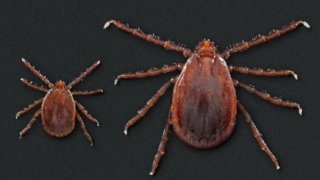
Town officials said several Asian longhorned ticks were found in the Fairfield beach area.
The ticks were found on a dog and identified as Asian longhorned ticks by researchers from Western Connecticut State University's Tickborne Disease Prevention Laboratory.
The research team conducted a surveillance sampling of the overflow grass parking areas at Penfield Beach, and various areas at Jennings Beach, where they found a significant number of these ticks.
Researchers say this means that the ticks are now well-established in the Fairfield Beach area.
Get Connecticut local news, weather forecasts and entertainment stories to your inbox. Sign up for NBC Connecticut newsletters.
Asian longhorned ticks are known to transmit disease in other countries, but aren't known to transmit any diseases to humans or pets in the U.S. They can be a concern to livestock, and at some point in the future, they could become a vector for diseases across the country, according to health officials.
Town officials said they're working with the WCSU research team to implement mitigation strategies. The town has already started to trim back bushes, grasses and other plants from beach area sidewalks and other walking areas.
The first Asian longhorned ticks in Connecticut were found in 2020 and six ticks were identified in Fairfield since Sept. 2021.
Local
In temperate climates, female adult Asian longhorned ticks can produce 1,000 to 2,000 eggs at a time without mating. That means individual animals could each host hundreds to thousands of ticks, according to The Connecticut Agricultural Experiment Station (CAES).
The adult female ticks are 2.7 to 3.4 mm long and 1.4 to 2.0 mm wide whereas the nymphs are 2.8 mm and 0.3 mm. Larvae and nymphs infest birds and small mammals and adults infest large animals such as cattle, sheep, goats, horses, dogs, cats, and wildlife.
The health department is urging residents to take precautions to prevent tick bites anywhere in town, especially in grassy, brushy or wooded areas where the ticks typically live.
Before going indoors:
- Treat clothing and gear with products containing 0.5% permethrin.
- Use Environmental Protection Agency (EPA) registered insect repellents that contain DEET, picaridin, IR3535, Oil of Lemon Eucalyptus, para-menthane-diol, or 2-undecanone.
After coming indoors:
- Check your clothing for ticks. Ticks may be carried into the house on clothing. Any ticks that are found should be removed. Tumble dry clothes in a dryer on high heat for 10 minutes to kill ticks on dry clothing after you come indoors.
- Examine gear and pets. Ticks can ride into the home on clothing and pets, then attach to a person later, so carefully examine pets, coats, and daypacks.
- Shower soon after being outdoors. Showering within two hours of coming indoors has been shown to reduce your risk of tickborne diseases. Showering may help wash off unattached ticks and it is a good opportunity to do a tick check.
- Check your body for ticks after being outdoors. Conduct a full body check upon return from potentially tick-infested areas, including your own backyard. Use a hand-held or full length mirror to view all parts of your body. Check these parts of your body and child’s body for ticks:
- Under the arms
- In or around the ears
- Inside the belly button
- In and around the hair
- Between the legs
- Around the waist
If you find a tick on yourself or another, carefully remove it with tweezers. Place the tick into a ziploc bag and bring it to the Fairfield health Department, where staff will determined the tick species.
For more information on Asian longhorned ticks, click here.



